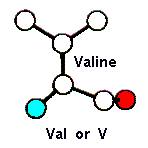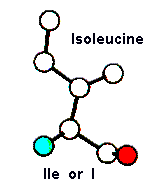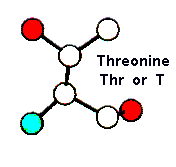


For an updated version of these pages, click here



Whereas most amino acids contain only one non-hydrogen substituent attached to their C-beta carbon, C-beta branched amino acids contain two (two carbons in Valine or Isoleucine; one carbon and one oxygen in Theronine) . This means that there is a lot more bulkiness near to the protein backbone, and thus means that these amino acids are more restricted in the conformations the main-chain can adopt. Perhaps the most pronounced effect of this is that it is more difficult for these amino acids to adopt an alpha-helical conformation, though it is easy and even preferred for them to lie within beta-sheets.